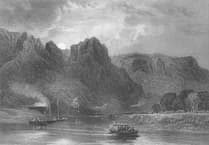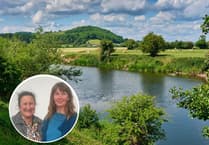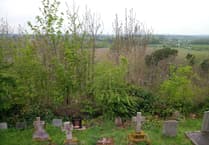An atmospheric cave, hidden amongst woodland on the Doward may star as a location in the upcoming film King Arthur, but it has always been one of Herefordshire’s hidden gems, and as the weather gets nicer, it makes a perfect picnic spot.
The Doward is a landscape steeped in history, and its narrow, twisty lanes, forested slopes and tumbledown ancient walls suffuse it with a strange, sometimes unsettling atmosphere. King Arthur’s Cave, a dark void in a mass of carboniferous limestone, 345 million years old, epitomises this. Accessed via a narrow track, the cave looks out into a venerable oak, ash and beech woodland which undulates down to the River Wye rushing below.
While this may set the perfect backdrop for the playing out of dramatic scenes – such as the recently filmed King Arthur – there is a regular cast of characters on the set which are worth watching too. On the breeze above, listen for blackcaps and pied flycatchers, and watch for the flash of red of a great spotted woodpecker.
Woodland butterflies, including pearl bordered fritillary, wood white and grizzled and dingy skippers flit through the dappled shade, while rare orchids (including bee, fly, greater butterfly and green winged orchid) have all been seen in this landscape. The caves dotted through the landscape are home to colonies of several species of bats (which roost there during summer days and hibernate through winter.)
Herds of fallow deer roam the Doward too – today undisturbed by medieval hunting parties – while dormice, foxes and badgers and numerous other small mammals scuffle unseen through the woodland scrub.
Though the specific historical significance of King Arthur’s Cave is unknown, through a jumbled Dark Ages translation, an older form of “Doward” can be loosely linked with the name "Arthur" (Deu Arth), which probably explains why this cave is reputed to be (along with hundreds of other British localities!) where King Arthur lies sleeping.
More interesting perhaps, or at least more factual, is solid evidence that the cave served as a shelter all the way back to neolithic times. Remnants of such occupants as giant elk, mammoths, woolly rhino, horse, cave bear and lions have been discovered there, along with flints used by hunters of the paleolithic and mesolithic eras. These people were the first of many to enjoy the security of this cave, whose ‘cosy’ recesses extend into the depths of the ancient hill.
Many areas within the Doward are managed by Herefordshire Wildlife Trust. The Trust’s current appeal is raising funds to continue the management and increase the accessibility of their 55 reserves. To donate, please visit www.justgiving.com/HerefordshireNatureReserves.





Comments
This article has no comments yet. Be the first to leave a comment.